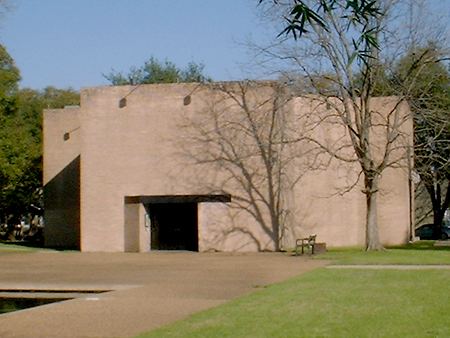Area less than one acre NRHP Reference # 00000883 Architectural style Modern architecture | Built 1971 Added to NRHP August 16, 2000 Owner Rothko Chapel Board | |
 | ||
Location 1409 Sul Ross Ave., Houston, Texas Address 3900 Yupon St, Houston, TX 77006, USA Hours Open today · 10AM–6PMThursday10AM–6PMFriday10AM–6PMSaturday10AM–6PMSunday10AM–6PMMonday10AM–6PMTuesday10AM–6PMWednesday10AM–6PMSuggest an edit Similar Menil Collection, Museum of Fine Arts - Houston, Byzantine Fresco Chapel, Contemporary Arts Museum, Houston Museum District Profiles | ||
Morton feldman rothko chapel
The Rothko Chapel is a non-denominational chapel in Houston, Texas, founded by John and Dominique de Menil. The interior serves not only as a chapel, but also as a major work of modern art. On its walls are fourteen black but color hued paintings by Mark Rothko. The shape of the building, an octagon inscribed in a Greek cross, and the design of the chapel was largely influenced by the artist.
Contents
- Morton feldman rothko chapel
- David dondero rothko chapel
- History
- Architecture
- Works of art
- Paintings
- Sculpture
- Music
- Recognition
- References
Susan J. Barnes states "The Rothko Chapel...became the world's first broadly ecumenical center, a holy place open to all religions and belonging to none. It became a center for international cultural, religious, and philosophical exchanges, for colloquia and performances. And it became a place of private prayer for individuals of all faiths"
On September 16, 2000, the Rothko Chapel was placed on the National Register of Historic Places.
David dondero rothko chapel
History
In 1964 Rothko was commissioned by John and Dominique de Menil (also founders of the nearby Menil Collection) to create a meditative space filled with his paintings. The works are site-specific, one of the requirements of the program. As Rothko was given creative license on the design of the structure, he clashed with the project's original architect, Philip Johnson over the plans for the chapel. The plans went through several revisions and architects. Rothko continued to work first with Howard Barnstone and then with Eugene Aubry, but ultimately he did not live to see the chapel's completion in 1971. After a long struggle with depression, Rothko committed suicide in his New York studio on February 25, 1970.
From 1973 onward, the Rothko Chapel doubled as a center for colloquiums aimed at fostering mutual understanding on issues affecting justice and freedom throughout the world. The first colloquium drew scholars from Lebanon, Iran, India, Pakistan, Nigeria, Japan, Italy, the United States and Canada. In 1981, it initiated “The Rothko Chapel Awards to Commitment to Truth and Freedom." In 1986, a second award was established to honor and emulate the spirit of Oscar Romero, Archbishop of San Salvador, who was murdered on March 24, 1980. These Rothko Chapel Awards have recognized individuals and organizations who, at great risk, denounce violations of human rights. In 1991 the Rothko Chapel marked its 20th anniversary with a joint award with the Carter-Menil Human Rights Foundation, founded in 1986 with former President Jimmy Carter. Nelson Mandela was the keynote speaker and received the special Rothko Chapel award.
In early 1999 the Rothko Chapel closed for a major renovation. The paintings had been exhibiting premature signs of age, and the largest could not be removed for treatment. In 2000, the chapel reopened after an 18-month, $1.8 million renovation, with the artist's paintings newly restored.
Architecture
The chapel is an irregular octagonal brick building with gray or rose stucco walls and a baffled skylight. It serves as a place of meditation as well as a meeting hall and is furnished with eight simple, moveable benches for meditative seating; more are provided to accommodate the audience for special events. Holy books from several religions are available. About 55,000 people visit the chapel each year.
Works of art
The chapel is associated with several works of art other than the building itself, in the fields of painting, sculpture, and music.
Paintings
Fourteen of Rothko's paintings are displayed in the chapel. Three walls display triptychs, while the other five walls display single paintings. Beginning in 1964, Rothko began painting a series of black paintings, which incorporated other dark hues and texture effects. A typical question raised by visitors viewing the massive black canvases which adorn the walls of the chapel includes some variant of: "Where are the paintings?"
The de Menils offered Rothko a commission for the chapel in 1964. From the fall of 1964 through the spring of 1967, he painted the fourteen large paintings and four alternates, which incorporated many of the characteristics of the earlier 1964 black paintings.
Sculpture
A distinctive sculpture by Barnett Newman, Broken Obelisk, 1963–1967, stands in front of the chapel. The sculpture sits in a reflecting pool designed by Philip Johnson and it is dedicated to the late Martin Luther King, Jr. The sculpture originally stood in Washington, D.C. and was offered in 1969 by the de Menils to the city of Houston as a memorial to Martin Luther King, Jr. to stand in front of City Hall. Houston turned down the gift and the de Menils then donated the sculpture and the Rothko paintings to start the Rothko Chapel.
Music
One of Morton Feldman's best known pieces of music was inspired by and written to be performed in the chapel — it too is called Rothko Chapel (1971). The musician Peter Gabriel named one of his songs Fourteen Black Paintings after his experience in the chapel.
Recognition
The Chapel has received numerous awards, including the Peace Award from The Houston Baha’í Community (1998), a Community Award from the Museum District Business Alliance (2000), The James L. Tucker Interfaith Award from Interfaith Ministries (2004), an Urban Greenery Award from The Park People (2005), and recognitions from the Houston Peace and Justice Center (2008).
